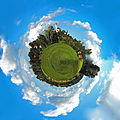Little Planet
Little Planet (English for small planet), sometimes also Tiny World (English for tiny world), is the name for an image processing technique that creates a distortion from a single photo, a surface or a spherical panorama by placing the image plane on a Spherical surface is projected stereographically . The result of this distortion makes the scenery appear small, often cute. The projection process causes the floor to shrink to a small round surface, surrounded by sky all around. Such little planet photographs are reminiscent of the view of space travelers on the earth. The typical application of Little Planet photographs are landscape and city panoramas as well as panoramas with striking buildings.
There is no equivalent term for Little Planet in the German-speaking world.
Recording technology and projection method
A little planet is technically created by stitching ( English stitch, " sew ", "staple"). Since the viewing angle of a single photo is often insufficient to achieve the desired effect, a motif is photographed in several individual shots. Ideally, all viewing angles of 360 ° horizontally and 180 ° vertically are captured and combined to form a large-format image ( spherical panorama ). Surface panoramas with a horizontal viewing angle of 360 ° and a restricted vertical viewing angle (approx. 100 °) can also be used, but then parts of the sky (zenith) or parts of the ground (nadir) are missing. A VR system consisting of a tripod , leveler , rotator, panorama head and circular level (also known colloquially as the nodal point adapter ) enables the necessary individual images to be created by rotating the camera around the center of the entry pupil of the lens to avoid the parallax shift between the foreground and background if necessary swivels.
In classic photo editing programs, creating a panorama image from several individual photos is associated with a lot of manual work. Special programs for panoramic photography (stitcher) sort the individual shots, sew them together in the overlapping areas, largely compensate for parallax errors as well as color and brightness deviations and then create a little planet from the panorama image. With careful work, no seams are visible. Image editing programs offer a similar, but rarely pixel-perfect, process. Here, the original image is deformed with the polar coordinate transformation filter (or a similar filter designation) so that the right side of the image collides with the left side of the image. The point of intersection usually has to be retouched. There have been apps since 2015 that use this technology to create a little planet from digital photos.
The image sequence on the right shows the typical workflow when creating a Little Planet panorama. The math behind it is the stereographic projection . This technique can also be used to achieve the opposite effect, known in English as a tube or mouse hole . In the software you pull the sky together to a hole in the middle and sew the small planet around it.
Examples
Schleissheim Castle (front)
Bergkirchen (district of Dachau)
Individual evidence
- ↑ From top to bottom: 34 single photos, put together as a spherical panorama, including a stereographic projection. Below: Adjusting the coordinates of the stereo projection until the edges meet. Finally, there is a rotation and color adjustment between the last two images.





